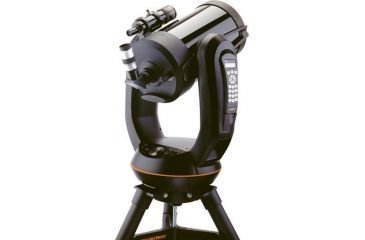



Tap Tap to Zoom
Product No Longer Available
Unfortunately Celestron NexStar 8 GPS Telescope 11052 is not listed by OpticsPlanet.
Product Info for Celestron NexStar 8 GPS Telescope 11052
Celestron NexStar 8 GPS Schmidt-Cassegrain Telescope 11052 is part of Celestron's "Top-of-the-Line" fork-mounted astronomical telescopes. 8GPS Celestron NexStar Telescope is at home as a superb visual instrument or, with optional CCD cameras, as a serious scientific research tool.![]()
Besides seeing all of the Messier Catalog objects, you can also see hundreds of other, less famous, but equally interesting NGC, IC and Caldwell objects. Turn NexStar 8 GPS Telescope to the planets and see amazing detail on the surface of Jupiter; see Cassini's Division in the rings of Saturn, and resolve details on the surface of Mars. Even the distant Uranus, Neptune and Pluto are within your reach.
Although large in aperture, with its conveniently located carrying handles and an instrument weight of only 42lb., Celestron 8-GPS Telescope is portable enough to set up in your backyard or take with you to your favorite dark sky location.
With StarBright XLT Optical System Design you'll see the light. One of the most important factors in the evaluation of a Schmidt-Cassegrain telescope 's optical system performance is its transmission - the percentage of incoming light that reaches the focal plane. The design of the XLT System accomplishes two crucial objectives: Develop a coating system that is optimized for visual use and for CCD/Photographic imaging.
There are three major components that make up Celestron StarBrightXLT high transmission optical system design:
1) Unique enhanced multi-layer mirror coatings: Celestron mirror coatings are made from precise layers of Al (Aluminum), SiO2 (quartz) and TiO2 (Titanium Dioxide). Reflectivity is fairly flat across the spectrum, optimizing it for both CCD imaging and visual use.
2) Multi-layer anti-reflective coatings: Coatings are made from precise layers of MgF2 (Magnesium Fluoride), and HfO2 (Hafnium Dioxide). Hafnium gives a wider band pass than Titanium, used in comparable coatings.
3) High Transmission Water White glass : Celestron Schmidt-Cassegrain optical systems with optional StarBright XLT coatings use Water White glass instead of Soda Lime glass for the corrector lens. Water White glass transmits about 90.5% of light without anti-reflective coatings. That is 3.5% better transmission than uncoated Soda Lime glass. When Water White glass is used in conjunction with StarBright - XLT 's anti-reflective coatings, the average light transmission reaches 97.4% - an 8% improvement!
These three components of Celestron StarBright XLT coatings result in one of the finest coatings available. The peak light transmission for the systems is 89% at 520 nm. The overall system transmission is 83.5% averaged over the spectrum from 400 to 750 nm.
Click here to see details about StarBright XLT .
Specifications for Celestron Nex Star 8GPS Telescopes 11052:
| Design: | Schmidt-Cassegrain Catadioptric | |
| Aperture: | 8" (203.2mm) | |
| Focal Length: | 2032mm | |
| F/ratio of the Optical System: | 10 | |
| Central Obstruction: | 2.7" | |
| Highest Useful Magnification: | 480x (~4mm eyepiece) | |
| Lowest Useful Magnification(7mm exit pupil): | 29x (~70mm eyepiece) | |
| Magnification: | Standard Eyepiece ( 40mm Pl) | |
| Resolution: | Rayleigh Criterion Dawes Limit | |
| Photographic Resolution (theoretic at 410nm): | 200 line/mm | |
| Light Gathering Power: | 843x | |
| Near Focus w/ standard eyepiece or camera: | ~25 feet | |
| Field of View: | Standard Eyepiece | |
| Linear Field of View (at 1000 yds): | 47.5 ft. | |
| Optical Tube Length: | 21" | |
| Input Voltage: | 12 V DC Nominal | |
| Maximum: | 15 V DC Max. | |
| Minimum: | 9 V DC Min. | |
| Power Supply Requirements: | 12 VDC-1.5A (Tip positive) | |
| Cord Management: | Internal Slip Ring Design | |
| Motor: | Type Resolution | |
| Slew speeds: | Nine slew speeds | |
| Hand Control: | Double line, 16 character Liquid Crystal Display 19 fiber optic backlit LED keypad | |
| Weight of Telescope: | 42 lbs | |
| Weight of Tripod: | 26 lbs | |
Features of Celestron NexStar-8GPS Telescope 11052:
- StarBright Multi-Coatings
- Dual Fork Arm
- Carbon Fiber Optical Tube
- Fastar Compatible for f/2 CCD Imaging
- Double line, 16 character Liquid Crystal Display; 19 fiber optic backlit Computer Hand Control
- RS-232 communication port on hand control
- Auxiliary Port and Autoguide Port on Drive Base
- 40,000+ object database
- 16 channel GPS Receiver
Package Contents:
- Celestron NexStar 8 GPS Telescope 11052
- 1-1/4" 40mm Eyepieces (51x)
- 1-1/4" Star Diagonal
- 9x50 Finderscope and Mounting Bracket
- 1-1/4" Visual Back
- AC Adapter (car battery adapter is included with some models)
- Heavy Duty Tripod
- NexRemote Telescope Control Software